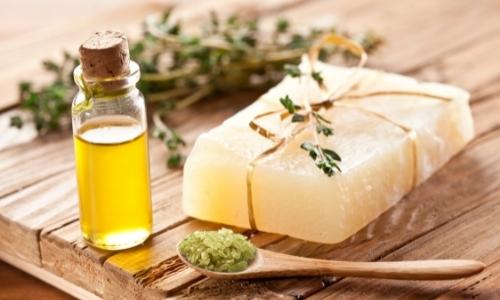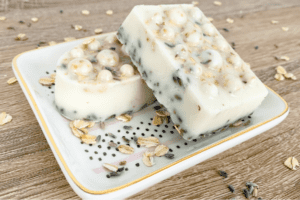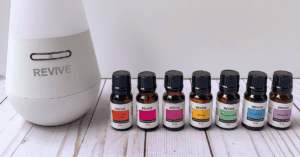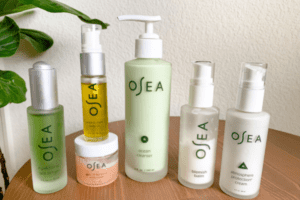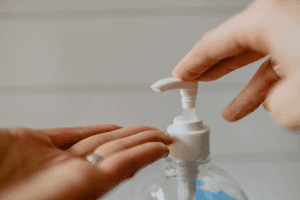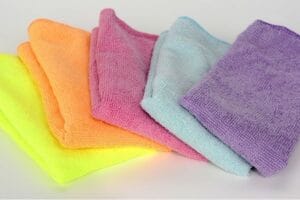20+ Natural Soap Colorants for Melt and Pour Soap Recipes
Check out this list of natural soap colorants to make your homemade soap look amazing
Natural soap is more popular than ever before, and so are the benefits of using natural ingredients in your homemade products. But it can be hard to find a good source of information on natural soap colorants. Like what plant-based powders will work best with which recipe.
This article has all the answers you need! You’ll learn about some different ways that you can use nature’s bounty as a coloring agent in your melt and pour soaps, as well as other bath products like shampoo bars and body scrubs.
But first, it’s super important for you to understand why conventional soap dyes are best left on the shelf.
This post contains affiliate links. You can learn more here.

What Dye is Safe for Soap?
Did you know that most artificial dyes have negative effects on your health? Conventional dyes like FD&C Red 40, Yellow 5 and 6, and Blue 1 are made from chemicals that can be harmful enough to cause hyperactivity in children or even cancer.
And this doesn’t just apply to soap! Artificial dyes can be found in just about anything and everything. Whether it’s food or your conventional beauty products.
That’s why natural colorants for soap recipes need to come from natural ingredients instead. You’re lessening your toxic exposure and giving your body a break from having to detox all those nasty ingredients.
The bottom line here is that nature-made dyes are perfect for things like melt and pour soaps. This includes plant-based powders with their own unique hues that translate beautifully to soaps.
While you can certainly use conventional dyes, they’re ultimately not good for your health. It’s better to ditch them and go with a colorant for soap that’s likely sitting in your pantry.
What Can You Use to Color Soap Naturally?
Plant-based powders made from roots and other sources are your best friend for beautifully-colored homemade soap! They come in natural hues that you can mix up to create just the right color for your recipe.
It might take a trial run to find just the right color you’re after, but you’ll be left with beautiful results that can make a great gift.
Each plant powder in this list will have its own unique hue along with added skin care benefits that you won’t get from a conventional dye. I’ve organized them based on the colors of the rainbow (Along with any variations).
Please note that these natural colorants will NOT look like most of the conventional bar soaps you can find at the store. You won’t find any bright reds, greens, or blues here!
Instead, the colors are a more muted pastel version of their toxic counterparts. If you’ve ever wandered into a natural soap store, did you ever notice that there were no bright or neon colored options?
Plants come from the Earth, so all natural soap colorants will have some kind of earthy undertone. But don’t worry, you can still make them look fabulous! I personally find the colors to be more relaxing and less fake-looking.
Where to Buy Natural Soap Colorants
Depending on what color you’re going for, you can find your desired colorant at the grocery store or online! Some powders can easily be found right in your pantry, like cocoa powder.
However, some natural soap colorants are a little bit on the rare side, which will require a trip to Amazon. But once you make an order, it should last you a very long time.
I’ll have links to all of my favorite soap colorant options from Amazon within this list for your convenience. Just keep in mind that this list will strictly be of powders or other non-food substances.
List of The Best Non-Food Natural Soap Colorants
If you’ve done some searching around for natural soap colorants, you might have noticed that some people use real food to color their soap. I personally don’t like that method for a couple of reasons.
One, it’s a lot of extra work because you usually have to steam or cook your food (like carrots in orange soap, for example) before you mash it up and add it to your soap.
Two, and the main reason why I don’t like raw food soap colorants, is because the food will slowly go bad within the soap itself. This will also change the color!
I’ve seen soap go from a super vibrant orange to a disgusting brown in just a couple of weeks. You don’t want to wash yourself with rotten food!
That’s why all of these natural soap colorants are either a powder made from a dried plant, or a kind of clay. And don’t worry, I’ve got powder for every color of the rainbow and then some! So let’s get started.
Natural Red and Pink Soap Colorants
Sandalwood Powder—If you’re looking for a natural red colorant, this is your best option. It’s got a deep brown hue that will easily mix to create a natural shade of red, pink, or even orange depending on how much or how little you use.
Traditionally used in Ayurvedic medicine for psoriasis, eczema and other skin ailments, this would make a great addition to soap for someone with dry or inflamed skin.
Moroccan Red Clay—This one will provide a natural red color as well, with a slightly more orange undertone than the sandalwood powder. Think of it as a happy medium if you don’t want fire engine red soap.
Traditionally used in western medicine for cleansing and detoxing the body, it would be perfect for those who want a little bit of skin clarification. What I love about natural clays are that they have a natural exfoliating quality to them.
Rose Kaolin Clay—One of my personal favorites for beautiful pink soap! Rose clay has a lovely pink hue that’s perfect for using in melt and pour soap recipes. You can use a small amount for and earthy light pink or a bigger amount for a more traditional pink.
I love it because it does have some natural detoxing qualities to it, but not as powerful as Moroccan red clay. This would make a great natural soap colorant for someone with normal skin who wants a little bit of aesthetically pleasing skin care benefits.
Colorants for Orange Soap
Paprika—This common spice will give you a nice vibrant or light colored orange soap. It’ll look natural and beautiful, not fake or “ignited.” Just be careful that too much might be an irritant for those with sensitive skin!
With a natural anti-inflammatory function that’s been known to help with digestive health, I think it would be a great natural soap colorant for someone who wants a little bit of skincare benefits in their shower routine.
Turmeric—Another anti-inflammatory powder you can find in your pantry. This one will give you more of an orange-yellow result instead of a pure orange like paprika.
I love natural soap colorants like this because you can add a bit to your natural soap recipes and make things easier for yourself! It’s basically like natural food coloring that will help with your skin care.
Safflower Petals—One of the few non-powders on this list, dried safflower petals can give the brightest orange desired. You can grind the petals with a mortar and pestle to make them smaller, or add them straight in.
Either way, this soap will be a lovely natural exfoliant with flecks of darker orange scattered throughout. It’ll provide a natural scrub while also creating a beautiful natural orange shade in your melt and pour soaps!
Natural Yellow Soap Colorants
Curry Powder—For a natural yellow soap, curry powder is your best bet! It’s easily blended with oils and butters to make a shade of light yellow. Just be aware that the smell will fade, so don’t panic if you don’t want your soap to smell like an Indian cuisine restaurant.
Traditionally used as an anti-inflammatory agent in Ayurvedic medicine, it’ll be perfect for those with inflamed or dry skin who want some natural relief. And you can get a more muted or deep yellow, depending on how much you use.
Calendula Petals—Another natural soap colorant that’s not a powder, calendula petals will give you light yellow tones as opposed to the deep earthy yellow tones of curry.
Calendula is one of the best herbs for calming inflammation, so I highly recommend these petals for anyone suffering from skin ailments and need something that won’t make it worse. Plus, they look beautiful in your melt and pour soap!
Saffron—Finally, we’ve got one more spice that you can find in your pantry! Saffron is a natural food coloring you can use in your melt and pour soap recipes to obtain a lovely yellow color.
This spice works as an antidepressant and anti-inflammatory natural remedy that’s been used for centuries. With such strong skincare benefits like these, I think it would be perfect for any soap you want to be a fun yellow.
Colorants for Natural Green Soap
Spirulina—While this natural soap colorant isn’t in your pantry, you might want to consider this if you’re looking to make soap in natural green colors. Spirulina is one of the best natural options for a lovely dark green hue!
Traditionally used as an anti-inflammatory and detoxifying, spirulina is typically used in drinks to help with digestion and other issues. Just keep in mind that this makes more of a sea green than traditional green color.
Indigo Powder—For natural green coloring, indigo powder gives you a natural deep forest green that’s quite gorgeous. And the best part is that you don’t have use use a whole lot for a desired green effect.
Just be very careful when making your soap! Indigo powder is notorious for staining. I wouldn’t recommend you use it around children, and wear gloves so it doesn’t stain your skin.
Matcha—Matcha is a natural colorant that’s easy to use in melt and pour soap. You can easily get green tones in your soap, which will also have anti-inflammatory properties like spirulina or calendula!
The natural components of the plant are believed to reduce stress and inflammation, bring clarity of mind, and boost metabolism. One thing to note, however, is that matcha will give you the lightest green color out of everything on this list.
Sage—This natural soap colorant is easily found in your pantry, so you don’t have to worry about buying anything special. Sage has natural anti-inflammatory properties and will give you a lovely traditional green hue.
You can blend the leaves with oils to get a dark natural green or steep whole sage leaves for light green hues. But don’t worry, I’ll go over how to add your powders to your soap in a minute.
Blue Soap Colorants
Spirulina Powder—A natural blue soap colorant made from algae, spirulina powder is very easy to use. You can blend it in with oils or fatty acids in your melt and pour soap recipes!
Notice that this powder was also in the green section? That’s because adding a bigger amount to your soap will give it a lovely blue-ish green color. Think more like sea blue than sky blue.
Indigo Root—If you want natural blue coloring, I recommend using indigo root powder! Just use a higher amount for a nice deep blue color instead of green. That’s why it’s also found in two color categories.
I also can’t stress enough that you should use gloves when working with this stuff! And wear clothes that you don’t mind staining. It’s all about precaution.
Blue Cornmeal—Here’s another natural soap colorant you might find in your pantry for blue melt and pour soap recipes! It’s the only item on this list that comes out as a pure blue, so this is for you if you don’t want any sea green tones to your soap.
This particular powder can give your soap a slight purple color, if you use it sparingly. Just don’t forget to do a trial run before you create a new soap!
Natural Purple Color for Soap
Madder Root—If natural purple is what you’re going for, I recommend making natural soap colorants from madder root! It’s the only natural source that’ll give you a true purple hue.
But anyone who has used natural soap colorants knows that the hue can change with the amount in the recipe. You can even get redish-hued soap if you use this powder in small amounts!
Alkanet Root—This natural soap colorant is another sea-inspired natural component. Just like indigo root, you can get natural deep purples with alkanet root powder!
Just keep in mind that this powder involves the extra step of being steeped in an oil before adding it to your melt and pour soap. But you’ll get the loveliest of purples as a result!
Brown, Black, and Grey Soap Colorants
Cocoa Powder—You can use brown soap colorants like cocoa powder (or cacao powder) to make a soap with a rich brown color. Just add the powder to your melted soap concoction like the other powders mentioned in this article.
Cocoa powder can give your soap a slight chocolate scent, which may or may not be what you’re after. I bet you could make a decadent chocolate soap with some vanilla or coffee beans!
Ground Cloves—Ground cloves can give your natural soap colorant a lovely light to dark brown hue, depending on how much you add to your melt and pour soap. I love that you likely have this powder in your pantry already!
If you don’t want a chocolate-y scent to your homemade soap, this is a great alternative. Depending on how much you add, this could even be a great addition to some fall-themed soaps!
Coffee Grounds—I bet you didn’t know you could use coffee grounds to make brown-hued soap! Of course, you need to make a pot of coffee to get a hold of this. Plus, the grounds would be a great exfoliator as you go through the soap.
It’s pretty simple, but it could give a nice natural earthy brown hue depending on how much you add to your recipe. If you add too much, you may end up with a dark brown to black color, so it’s worth it to experiment first.
Activated Charcoal—For natural black soap colorant, activated charcoal is a great choice. All you need to do is add it into your melt and pour soap and let the natural powder dissolve and mix with the rest of your desired ingredients.
You may want to think about what kind of natural colorants go well with activated charcoal! This is a good chance to try swirling two different colors of soap. Or adding fun things like small toys so they pop out of the dark coloring.
Bentonite Clay—For natural gray soap colorant, add bentonite clay! It’s a great detoxing agent for the skin and has no scent. It’s the perfect kind of melt and pour soap colorant.
If you do decide to use bentonite clay, make sure that you have moisturizing agents mixed into your soap. This clay can be quite drying to the skin, so you’ll need something like a carrier to balance things out.
How to Add Natural Powder Colorants to Melt and Pour Soap
When adding natural soap colorants to your melt and pour soap, it’s important to mix them well. You can do this by stirring the powder into your soap mixture or blending it with an immersion blender.
If you’re using a natural powder that needs to be steeped in oil before adding it to your soap mixture, like alkanet root, make sure that you use an oil that has little to no scent so it doesn’t throw off your finished product.
I suggest a light carrier oil like sweet almond, jojoba, or rosehip oil. I’d steer clear of something strong like coconut or even olive oil, unless that’s the kind of vibe you’re going for.
As for how much powder you should use, the rule of thumb is one tablespoon of powder for every pound of soap. Like I said before, you can add more or less for a desired outcome.
Another trick I’ve learned if you don’t have an immersion blender, is to add a little bit of filtered water to your powder to create a paste. This will make the mixing process much easier if all you have is a spoon and some determination.
Final Thoughts on Natural Soap Colorants for Melt and Pour
If you’re looking for a way to add color to your homemade soap without using conventional dyes, give natural soap colorants a try. You can find them at the grocery store, online, or even in your pantry.
They won’t be as bright, but will give your melt and pour soap a nice pastel or earthy color. Plus, they often have additional skin care benefits.
Have you tried using natural soap colorants in your own soaps? What colors did you choose?

